Origin Genesis Review: Triple Titan Terror
by Ryan Smith on April 23, 2013 9:00 AM ESTTitan Tri-SLI In-Depth: Letting Titan Spread Its Wings
Having taken a quick look at overall system performance, it’s time to get down to the real meat and potatoes of this review and of the Genesis’ existence: gaming.
The Genesis fundamentally exists for two reasons: you’re either playing on a triple monitor 2D/3D surround setup, or you’re playing Crysis 3. There is simply no other scenario where three Titan cards are necessary, as we’ll see. Genesis was meant to play games, and it was meant to do so at the highest resolutions with the highest settings; no compromise gaming at its finest.
To illustrate this point, we’ve run our Genesis system with 1, 2, and 3 Titan cards enabled to look at not only what its shipping performance is, but what scaling is like from 1 GPU to multiple GPUs. As we’ve discussed before, using multiple GPUs is not a foolproof way to improve performance due to the inherent limitations of AFR, but when we’re up to a single Titan card this is the only way to further improve performance.
We’re also throwing in numbers from our GPU testbed, where available. Since we can’t control for the differences in the testbed (not the least the cooling differences) we can’t hold the two of them equal. But we can at least showcase the difference between our testbed and the Genesis due to configuration, cooling, and CPU differences.
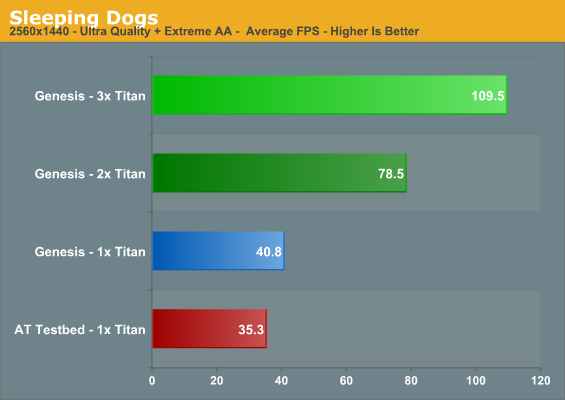
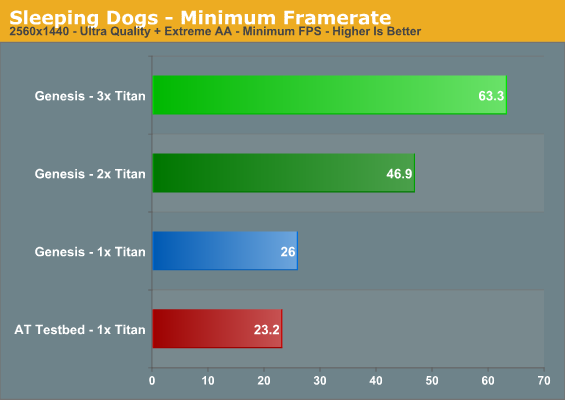
Sleeping Dogs’ benchmark doesn’t work correctly at 5760, so we’re stuck looking at 2560x1440 here. But even so it presents an interesting case study since Sleeping Dogs’ highest settings involve super-sample anti-aliasing nearly the entire screen, a performance-brutal but very effective method of eliminating jaggies. 1 Titan can’t do the job here while keeping average framerates above 60, so 2 are necessary. But to keep the minimum framerates above 60fps becomes a task for no less than 3 Titans.
Scaling ends up being very good here. 1 to 2 Titans is a 92% increase in performance. Meanwhile 2 to 3 Titans is not as great at 39% (out of 50%), but there’s also a very real possibility we’re hitting CPU limits here. As we’ll see, tri-SLI Titans can be very hard to feed even with a 4.9GHz SNB-E processor.

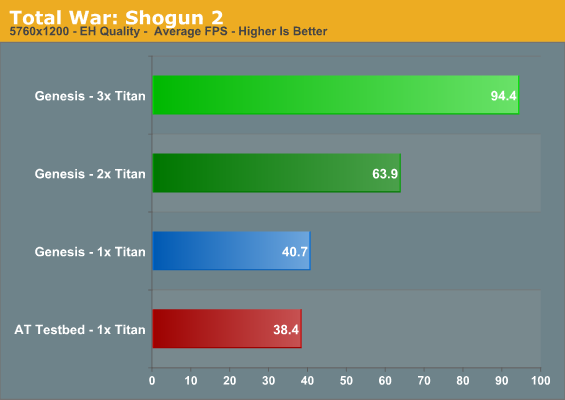
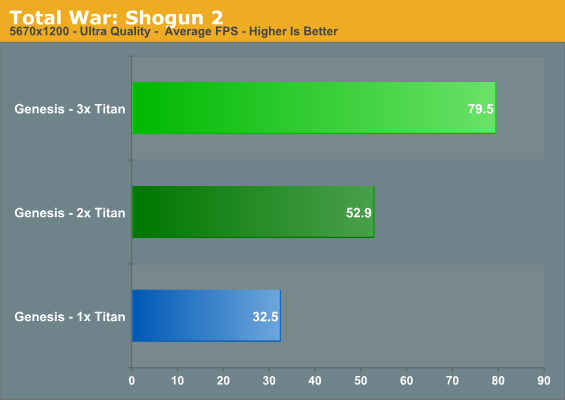
Total War 2 also scales up well with multiple Titans, though as a turn based strategy game there isn’t the same need for incredible performance here as there is with our action games. At 2560 even 1 Titan is more than enough, and at 5760 with absolutely everything cranked up, 1 Titan is still above 30fps. Still, you technically need 3 Titans to get ahead of 60fps. Oddly enough, at times the gains from a 3rd Titan are closer to the theoretical gains we’d expect than adding the 2nd Titan.
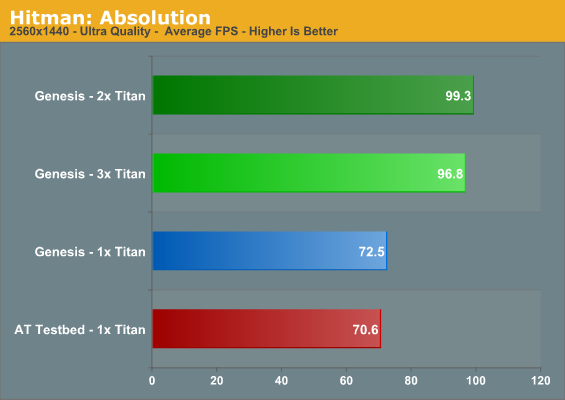
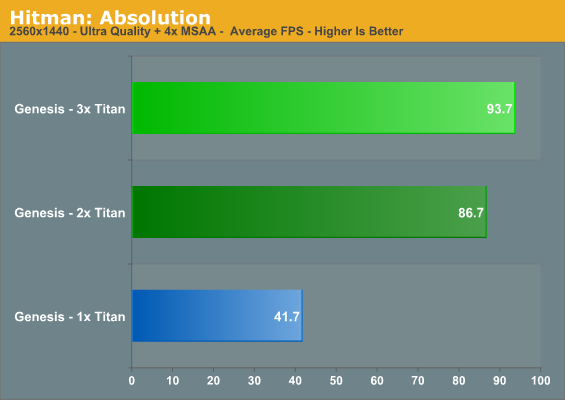
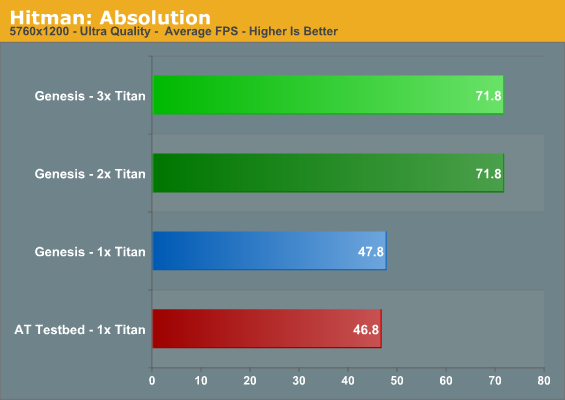
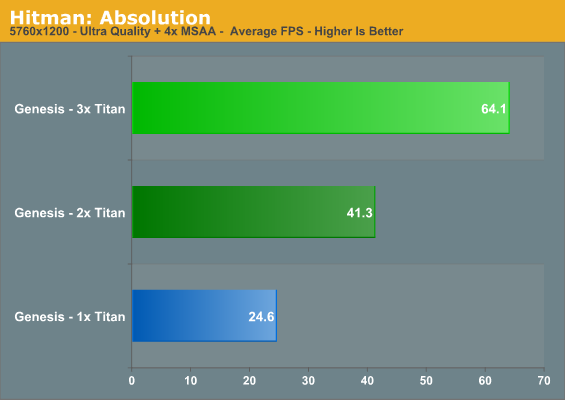
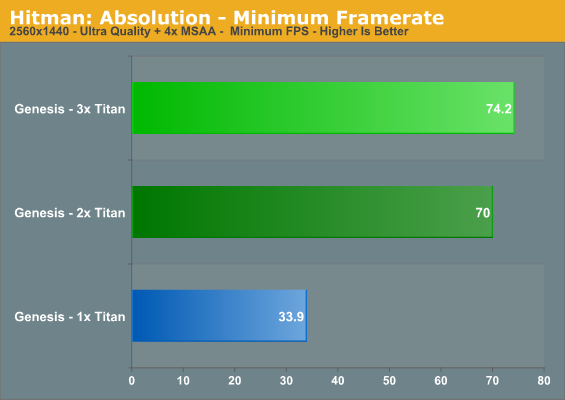
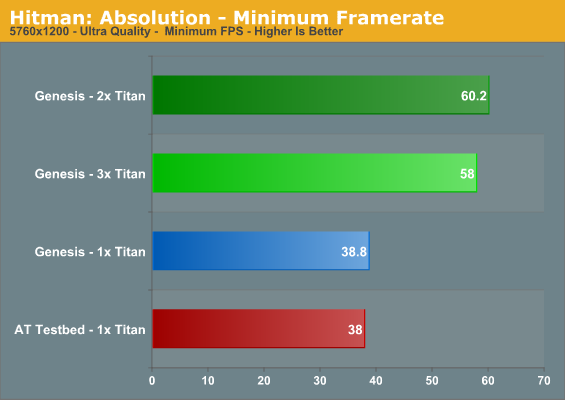
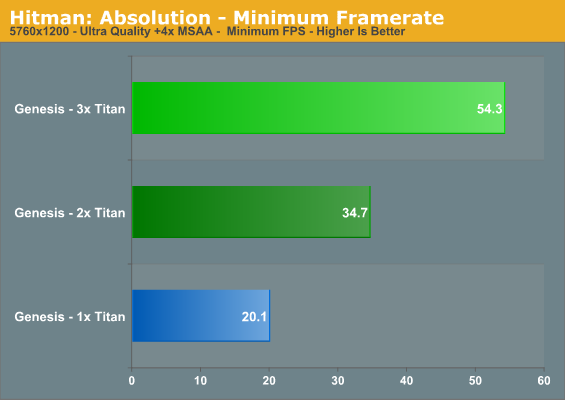
Hitman is our first good example of being CPU limited, which is a big problem any kind of multiple-Titan computer faces, including the Genesis. Thanks to the embarrassingly parallel nature of graphics rendering, the GPU side of the equation gets faster at a much greater rate than the CPUs feeding those GPUs, so it’s easy to get CPU bottlenecked, and even easier when dealing with multiple GPUs. Our in-game experience isn’t quite the CPU limited for the most part, but especially at lower resolutions the performance it’s hard to feed multiple Titans.
Overall anything short of 5760 with 4x MSAA fails to make a 3rd Titan worthwhile. On the other hand, you do need at least 2 Titans to handle MSAA even at 2560, with the 3rd making itself felt at 5760. So there is a use for 3 Titans even in a more CPU limited scenario, but it will require the highest resolutions with anti-aliasing, reinforcing the fact that the Genesis’ capabilities are best suited to driving a surround setup.










63 Comments
View All Comments
Pontius - Tuesday, April 23, 2013 - link
Ryan, a question for you:I remember that on the first Titan review, it said nVidia did not have OpenCL support in their Titan drivers and that they were working on fixing whatever issues they were having. Do you know if they have since released a driver that supports OpenCL? If not, do you have any info on a target date? If so, will you be benchmarking this (or other) Titan systems with OpenCL?
Thanks.
Ryan Smith - Tuesday, April 23, 2013 - link
Yes, OpenCL support has since been fixed for Titan. We have the results in bench and you should see them in other articles soon enough.Pontius - Tuesday, April 23, 2013 - link
Awesome, thanks!Pontius - Tuesday, April 23, 2013 - link
BTW, Bench appears to be completely broken. No matter what I select to compare, it keeps taking me back to the main CPU bench page.Ryan Smith - Wednesday, April 24, 2013 - link
D'oh.I'll get the web devs on it in the morning. Thank you for pointing that out.
Footman36 - Tuesday, April 23, 2013 - link
120gb SSD, no dedicated sound card and a case that can only accept 120x3 at the top is not going to cut it. Too loud, too hot. Why not use the new Corsair 900. Even though it is not yet available I am sure that Origin could have waited. It will retail at around $350 so not much more than the 800 and has room for 4x120 at the top, 3 x 120 at the front 4 x 120 bottom side and 1 x 140 at the back. Much more sensible cooling options. Would have handled the heat output better reducing load temps and noise. I have GTX 670's in SLI and 3770K all overclocked with a single 140 rad at the back and a triple 120 at the top of my Switch 810, so Origins cooling leaves me meh! And all this for the price of a cheap car! No thanks.7Enigma - Tuesday, April 23, 2013 - link
Ryan,I've seen this before in case reviews and it always confuses (annoys) me. You mention that the manual fans on high are loud, and you post values for the noise at 66% under load, but you don't post the TEMPERATURES of the CPU/GPU at that 66% load. Saying, "At these speeds the Genesis still has plenty of airflow for just about everything, but we would not recommend replicating our 1340W load testing at anything less than full speed since it was at these settings that we hit 81C under full load.", is just not very helpful. We want to know @66% are you now getting close to the limit of components when playing the most demanding game in your arsenal? What about the hard drive, ram, optical drive, etc. that now has to deal with hotter internal temperatures (especially because the top fans have now been forced to work against physics).
I just feel that when numbers are cherry-picked or not fully disclosed (low temps at high fan speeds, and low noise at low fan speeds) a potential buyer doesn't have much helpful REAL WORLD usage and the manufacturer gets put in a better light.
Great review otherwise, I just want to see those extra data points!
Ryan Smith - Tuesday, April 23, 2013 - link
The short answer is no, component temperatures don't get too bad when gaming at 66%. The GPUs never exceeded 62C, and the CPU never exceeded 75C. As for the other components, the SSDs and HDD are in their own bay; the only things of note cooled by the primary chamber are the VRMs and RAM, and the latter doesn't have temperature probes.7Enigma - Wednesday, April 24, 2013 - link
Thank you for the data! Any way you could put that in one of the tables above (or at least mention it in the gaming section)? And do that in the future if similar fan options are allowed?teiglin - Tuesday, April 23, 2013 - link
You accidentally claimed that there are 2000 square meters of silicon in this thing on the power/temps page; that'd be a pretty stunning amount of microchip!